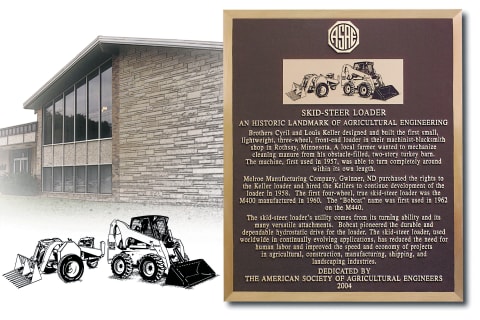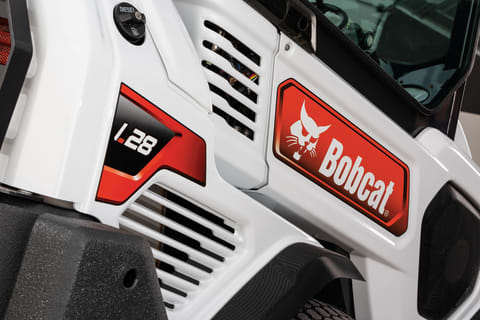- Home
- About Bobcat
- History
Bobcat Story
In a classic tale of American entrepreneurship, Edward Gideon "E.G." Melroe founded Melroe Manufacturing Company in Gwinner, North Dakota, in 1947. His notable inventions included the Melroe pickup, a combine attachment that would pick up windrows of grain, and the harroweeder, a spring-tooth harrow for weeding row crops. Melroe died in 1955, leaving his sons Lester, Clifford, Roger and Irving, and son-in-law Eugene Dahl, in charge of the business. The prosperous farm implement business changed course in 1958, after the brothers met with inventors Cyril and Louis Keller, from Rothsay, in western Minnesota.
The Kellers repaired machinery for local farmers, among them a turkey farmer Eddie Velo. One day in 1957, Velo stopped by the Kellers’ machine shop with a vexing problem. His two-story turkey barns needed cleaning, but his tractor loader couldn’t maneuver around the upright poles in the barns. Hand labor -- a nasty, dirty job -- was the only alternative. Velo needed a self-propelled loader light enough to be lifted to the barn’s second floor and maneuverable enough to clean around the support poles.
The Kellers assembled a simple front-end loader with two drive wheels and a small rear caster wheel. Powered by a 6 hp engine with a rope starter, it was steered by independent right and left control levers using a unique clutch mechanism. The front scoop’s fork tines were made of bars from the Rothsay jail, the only steel hard enough to do the job. The loader worked so well that the Kellers built six more and sold them to nearby farmers.
The Kellers' uncle, a Melroe farm equipment dealer at Elbow Lake, Minnesota, introduced his nephews to the Melroe brothers in the summer of 1958. They invited the Kellers to demonstrate the loader at the Minnesota State Fair, where it drew huge crowds. Realizing the potential, the Melroes agreed to a royalty arrangement with the Keller brothers for the clutch drive mechanism. Louis and Cyril Keller became employees of the Melroe Manufacturing Company, and they were assigned to design and manufacture the first Melroe self-propelled loader.
Fast forward six decades and a million loaders. The Bobcat brand – and its fabulous success story – is a worldwide icon. Follow the rest of the story along three timelines:

Corporate Timeline
See how the company grew, how product lines came and went, and the results of three ownership changes. Watch film clips that show how the products were marketed.

Product Timeline
Follow the development of the three major product groups: skid-steer loaders, compact track loaders and compact excavators. Timelines cover major model launches and the innovations tied to each.

Branding and Trade Dress Timeline
While the Bobcat brand hasn’t changed since its introduction in 1962, trade dress -- what appears on the product -- has changed dramatically.
Bobcat "Firsts"
Invention and entrepreneurship have described Bobcat and its people since the earliest days. Few inventions have done more to change the way the world works than the skid-steer loader in 1960. From it spawned the compact equipment business, of which Bobcat is the undisputed leader.
A decade later, another invention – the Bob-Tach™ system -- simplified changing of attachments. After the Bob-Tach patent expired, other manufacturers adopted the same design, and today it is the global ISO standard. It also resulted in the development of hundreds of job-matched attachments, and an industry comprising countless global manufacturers.
2000 to Present
8
2014
Bobcat is the first manufacturer to top 1,000,000 loaders.
2008
Bobcat is the first manufacturer to reach 750,000 loaders milestone.
2006
Bobcat 2300 is the first utility vehicle with a quick attachment change system, RapidLink™.
2005
First use of speed management on SJC joystick controlled loaders.
2004
MT52 and MT55 are the first mini-track loaders with a ride-on platform that can be quickly removed for walk-behind operation.
2003
5600 Toolcat utility work machine, described as a cross between a utility vehicle, pickup truck and skid-steer loader. Designed for the grounds maintenance market, it is the industry’s first hydrostatic utility machine with an all-wheel steer for extreme tight quarters operation. Able to transport two people, the Toolcat 5600 features an air-conditioned and heated cab, hydraulic dump cargo box, joystick-controlled lift arm, Bob-Tach attachment mounting system, and dozens of approved attachments.5600 Toolcat utility work machine, described as a cross between a utility vehicle, pickup truck and skid-steer loader. Designed for the grounds maintenance market, it is the industry’s first hydrostatic utility machine with an all-wheel steer for extreme tight quarters operation. Able to transport two people, the Toolcat 5600 features an air-conditioned and heated cab, hydraulic dump cargo box, joystick-controlled lift arm, Bob-Tach attachment mounting system and dozens of approved attachments.
2002
Bobcat is first to top 50,000 mini excavators milestone in North America.
2001
A220 is the industry’s first loader to combine all-wheel steer (AWS) with skid-steer operation, selectable at the touch of a button.
Bobcat is first manufacturer to hit 500,000 loaders milestone.
1950 to 2000
14
1999
G-Series loaders are the first to use a new deluxe instrumentation system, providing vital loader monitoring and diagnostic information in seven languages.
Hydraulic Power Bob-Tach makes it possible to change attachments at the push of a button, often without leaving the operator cab.
1996
First Keyless start option is offered on Bobcat loaders.
1994
Bobcat Interlock Control System (BICS™) prevents use of the lift, tilt and traction drive functions until the operator is in the seat with the Seat Bar lowered.
1989
Bobcat becomes the first manufacturer to build compact excavators in North America.
1983
Over the years, operator safety becomes a recurring theme, and the VHS video “Bobcat Bootcamp” replaces “Bobcat Kid”, which in turn is replaced by “Operator Improvement” in 1993. Today, Bobcat leads the industry with a wide range of operator safety training courses on DVD.
440 and 443 are the first to have a transversely mounted engine. Two years later, the 943 uses a similar transverse engine mounting, allowing the hydrostatic drive pumps to be belt-driven for more efficiency, lower noise and easier service access for routine maintenance. This transverse engine design is repeated on the 50 Series and succeeding loader generations.
1981
Seat Bar secondary operator restraint device incorporated into the new Bobcat 743 and other 40 Series loaders. The multi-purpose padded Seat Bar provides additional restraint protection that prevents operator from falling forward.
1974
Industry’s first safety film, “The Story of the Bobcat Kid” is produced to introduce good safety practices in the operation of a skid-steer loader. Written and filmed with a humorous storyline that invites watching, “Bobcat Kid” was widely distributed to train Bobcat dealer staff and customers, as well as high school and vocational school students.
1972
Bob-Tach system is patented and added to other Bobcat skid-steer loader models. After the Bob-Tach patent expires in 1989, the design is adopted by other manufacturers and eventually becomes the world ISO standard.
1971
371 Mini-Bob becomes the world’s smallest skid-steer, and that frame size is still in the lineup today. Because of its compact size, it is instantly popular in agriculture, and still frequently used in interior demolition, landscaping and construction.
1970
M970 is the world’s first skid-steer loader utilizing a hydrostatic drive system, giving it tremendous pushing and digging power.
First use of a rollover protective structure (ROPS) on the M970 (and the M371 in 1971.) It is incorporated in the rest of the line (M610 and M700) in 1972. By 1974 the ROPS is adopted by the whole skid-steer loader industry.
M970 is the first skid-steer loader to use a lever-actuated attachment mounting system (what would be called Bob-Tach) — in place of pin-on mounting — which allows operators to easily switch attachments.
1962
M440 is the first skid-steer loader to use the Melroe Bobcat® trademark.
1960
M400 is the world’s first skid-steer loader. For a time, it was also distributed through the Farmhand dealer organization, based in Hopkins, Minnesota.
1959
M200 is an improved version of the first Melroe loader.
1958
M60 is the first production model of the Melroe self-propelled loader.